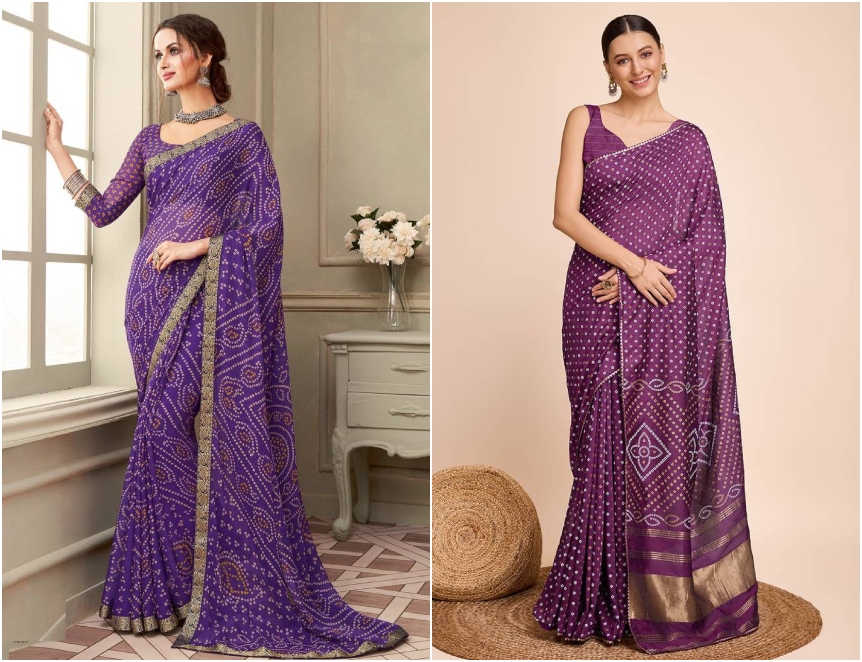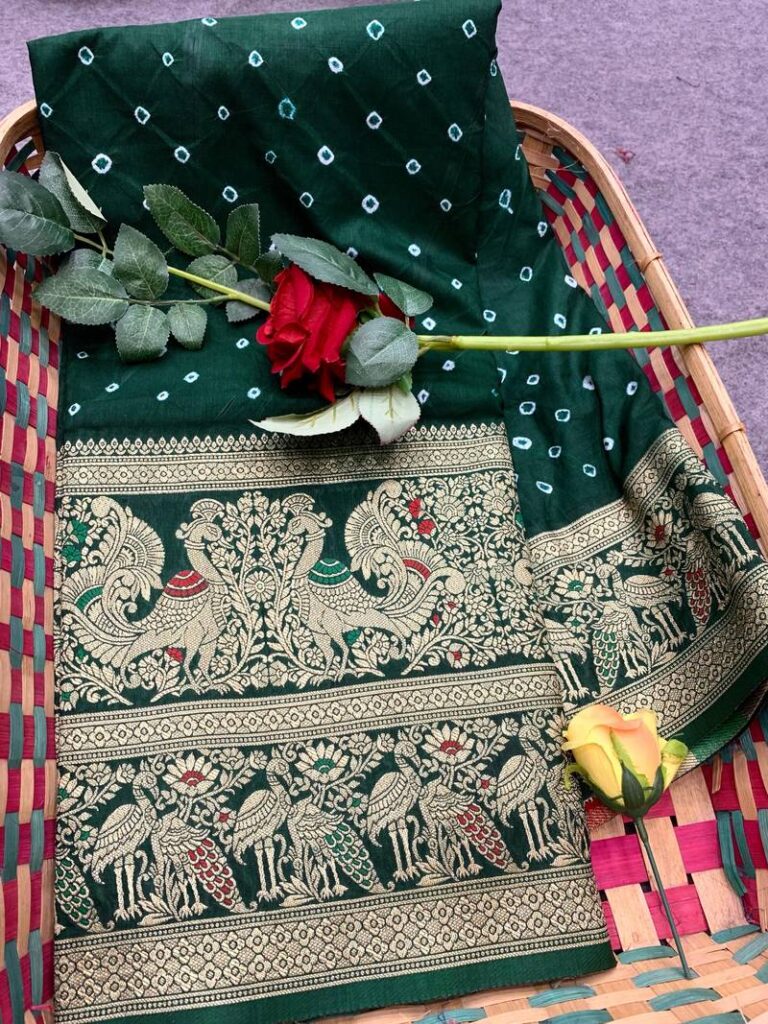
Bandhani Sarees – Timeless Dotted Patterns on Vibrant Background
Originating from the colourful and lively regions of Gujarat and Rajasthan, these sarees for woman are known to be the pride of these states. The centuries-old tie-dye technique involves carefully knotting fabric to create intricate patterns using the iconic white dots. Once a symbol of cultural significance, this Indian saree was primarily worn during joyous occasions like weddings and festivals. Today, its charm transcends time, finding its place in modern wardrobes for virtually every occasion, from casual gatherings to grand celebrations. While you may feel you do not know how these sarees look and where to wear them, we are here to help you with the same. Scroll down to learn all about these sarees! Based on the information you can buy sarees online without any hassles!
Fascinating Aspects of Bandhani Sarees
Colors: If the saree is monochrome, it often sports primary shades. Red, a prominent hue in Indian culture, symbolizes love and auspiciousness, making it a favorite for bridal and festive wear. Yellow, representing joy, warmth and prosperity, is often chosen for religious and ceremonial occasions, while green signifies harmony, fertility and new beginnings are frequently seen during celebrations. For the ones who want diverse colors, Bandhani sarees have those options. Pink is used to exude feminine grace, orange brings vibrancy, strength and creativity, and purple offers a touch of royal sophistication. There are other shades as well such as turquoise which symbolizes calmness, magenta that represents creativity and dark blue which is known for depth and stability.
Modern Bandhanis often come in two-tone combinations or ombré effects. Popular combinations include red and yellow; green and pink; purple and pink or blue and green. Black and red; mauve and ash grey or steel grey and pink are some of the unconventional combinations you can try. Ombré patterns offer a gradient effect such as transitioning from deep blue to light aqua or forest green to lime, symbolizing harmony and continuity. You can even try these in half-saree designs for a hassle-free look!
Motifs: There are simpler motifs are based on either the number of dots used systematically or the symmetry they represent. Popular designs include Ekdali (single dot), symbolizing simplicity and Trikunti (clusters of three dots), representing unity. Chaubundi style involves four small circles or squares placed in an aesthetically pleasing design. Boond (small dots) and Jaaldar (web-like patterns) depict raindrops and interconnectedness, respectively.

There are other motifs inclined towards elements deemed culturally important or prevalent. Shikargah motifs showcase animal or hunting scenes, reflecting royal heritage. Leheriya (waves), a popular bandhani of Rajasthan signifies water and prosperity while Ambadal (mango shape) symbolizes fertility and abundance. Another popular motif is Bavan Baug (fifty-two gardens), a complex pattern symbolizing prosperity and grandeur. Other motifs include haathi (elephant), vaagh (tiger), chakli chaklo (male and female sparrows), panihari (female figure carrying a pot of water), keri (paisley) and draksh (grape).
Occasions: After knowing the colors and motifs, it is time to know what kind of sarees can be worn at which events.If you are attending a family festive party or a grand religious occasion such as a ceremony, then a bandhani silk saree can be perfect as it has a mix of opulence and tradition. You can select a bandhani saree for weddings as well in fabrics such as silk or silk blends. A designer bandhani saree with more modern designs and color palettes can be great for office parties or cultural programs.
Ways To Increase The Shelf Life Of Your Bandhani Sarees
Cleaning
- Always choose to dry clean a new Bandhani saree to maintain its colors and texture
- For subsequent washes, hand-washing is recommended
- Use mild detergents or liquid soaps to wash sarees made of delicate fabrics
- Wash in cold water to prevent color bleeding
- Avoid scrubbing or twisting to avoid spoiling the bandhani saree design and fabric
- To prevent color transfer, wash light and dark-colored sarees separately
- You can add a pinch of salt or vinegar to the rinse water to help set the colors
- Do not use bleach, strong detergents or stain removers to prevent fabric and color damage
Storage
- Fold the badhni sadi along the natural creases to avoid wrinkles
- Place acid-free tissue paper between folds of the bandhani bandhej saree to prevent damage
- Store in breathable cotton or muslin bags to prevent moisture buildup and mildew
- Place cedar balls or camphor sachets to prevent pests like moths without damaging the saree
- Store in a cool, dry place and away from direct sunlight to prevent color fading
Usage
- Always iron on a low heat setting or use a steamer and iron on the reverse side
- Place a cotton cloth over the saree while ironing to prevent direct heat contact
- When you iron a heavy bandhani saree, avoid pressing the embellished or zari areas
- Refrain from wearing sharp-edged jewelry or accessories that could tangle with the saree and snag the fabric
- Be cautious while sitting or moving to prevent the saree from getting caught or torn
- Air out the saree before wearing it to eliminate any musty smell from storage
- Avoid wearing the same Bandhani saree frequently to minimize wear and tear



